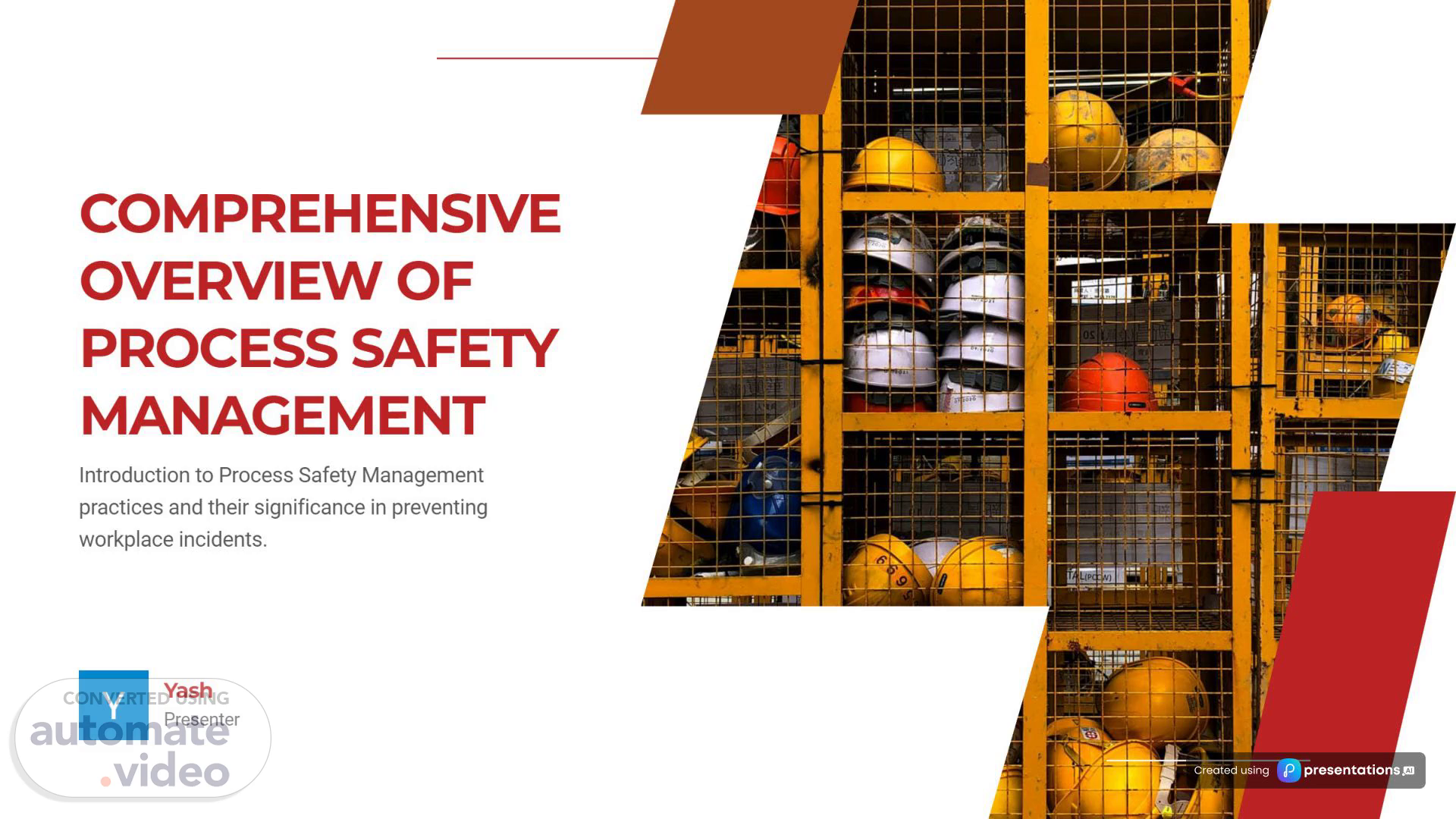Scene 1 (0s)
iiiiiii iiiiiiii SULZ COMPREHENSIVE OVERVIEW OF PROCESS SAFETY MANAGEMENT Introduction to Process Safety Management practices and their significance in preventing workplace incidents. Yash Presenter 1 f!eatéd using presentatio.
Scene 2 (8s)
INTRODUCTION TO PROCESS SAFETY MANAGEMENT Understanding the Need and Impact of PSM in Industries Bhopal Disaster The 1984 Bhopal disaster resulted in over 2,000 deaths, emphasizing the need for effective PSM. OSHA Standards OSHA standards are designed to mitigate risks associated with hazardous chemicals through regulation and oversight. Phillips Explosion In 1989, the Phillips explosion claimed 23 lives, showcasing the consequences of inadequate safety measures. Focus Areas of PSM Key focus areas include comprehensive training, robust procedures, and strict regulatory compliance to ensure safety. Created using presentations.
Scene 3 (31s)
UNDERSTANDING OSHA STANDARDS A Comprehensive Overview of Process Safety Management OSHA Standards Overview OSHA has developed standards aimed at improving safety in high-risk industries. Exceptions Noted Certain exceptions exist for hydrocarbon fuels and atmospheric tanks, highlighting specific focus areas. Focus on Manufacturing & Chemicals Standards specifically target the manufacturing and chemical industries to mitigate risks. Safety Measures for Contractors The standards emphasize necessary safety measures for contractors working in these environments. Coverage of Specific Chemicals Regulations include over 130 chemicals, ensuring meticulous safety management. Facility Operations Safety Facility operations are covered under these standards to ensure a safe working environment. Created using presentations.
Scene 4 (55s)
THE PROCESS AND SAFET•f INFORMATION Comprehensive Overview of Process Safety Management Chemical Hazards Identifies toxicity levels and exposure limits to ensure safety. Process Technology Includes flow diagrams and chemistry limits for better understanding. Equipment Specifications Covers materials, diagrams, and safety systems essential for operation. Created using presentations.
Scene 5 (1m 8s)
CONDUCTING PROCESS HAZARD ANALYSIS A systematic method to identify and evaluate hazards in process safety. What-If Analysis A brainstorming technique that evaluates potential hazards by asking 'What if?' FMEA Failure Mode and Effects Analysis assesses potential failure points and their impacts. Regular Updates The analysis must be reviewed and updated every five years to remain relevant. HAZOP Hazard and Operability Study focuses on identifying hazards through structured team discussions. OSHA Compliance Documentation of the analysis is essential for compliance with OSHA regulations. Created using presentations.
Scene 6 (1m 29s)
DEVELOPING OPERATING PROCEDURES Essential Steps for Effective Process Safety Management Operating Phases Cover startup, shutdown, and emergency procedures to ensure safety at all times. Safety Considerations Incorporate chemical hazards and necessary control measures to mitigate risks. Regular Reviews Procedures must be routinely reviewed and updated to reflect current practices and regulations. Created using presentations.
Scene 7 (1m 44s)
TRAINING AND DOCUMENTATION Essential Training for Safety in Process Management Importance of Training Initial and refresher training ensure safety in the workplace. Verification Methods Include verification methods to confirm training completion. Documentation Requirements Documentation must record employee identity and training dates. Hazard Awareness Training must cover safety and health hazards relevant to the job. Emergency Operations Training should include procedures for emergency operations. Created using presentations.
Scene 8 (2m 2s)
MECHANICAL INTEGRITY AND CONTRACTORS Ensuring Equipment Safety and Reliability in Process Safety Management lmPortance of Mechanical Integrity Mechanical integrity is vital to ensure the safe operation of equipment in industrial processes. Contractor Awareness Contractors must be educated about potential hazards associated with mechanical systems to enhance workplace safety. Focus on Pressure Vessels Pressure vessels must be regularly inspected and maintained to prevent failures that could lead to accidents. Adhering to Safety Protocols Following established safety protocols is critical for contractors to mitigate risks during maintenance and operations. Significance of Piping Systems Piping systems play a crucial role in transporting materials; their integrity is essential for preventing leaks and ensuring safety. Created using presentations.
Scene 9 (2m 25s)
INCIDENT INVESTIGATION AND COMPLIANCE Timely investigations and regular audits for PSM adherence 1 Initiate Investigation Conduct Compliance Audits Regular compliance audits are performed every three years to ensure that all processes align with Process Safety Management standards and regulations. 2 All incidents must be investigated within 48 hours to ensure timely and effective responses, including gathering descriptions and identifying contributing factors. Created using presentations.
Scene 10 (2m 43s)
CONCLUSION AND CALL TO ACTION Implement Process Safety Management for a Safer Workplace presentations Created using.
